
Summary
Welcome back to The Node Ahead, a cryptoasset resource for financial advisers. Every other week, we discuss the latest crypto news and the potential impacts it may have on you and your clients.
In this edition, we will review:
- Onchain Analysis
- What OpenDAO’s Airdrop Means for Opensea
- Major Crypto Bill in the Works
- Talent is Flocking to Crypto and Web3
- Onramp in the News
- In Other News
Onchain Analysis
Over the past month, as trading activity in the crypto markets slowed down heading into the holidays, bitcoin continued to trade in the $41k – $50k range. As mentioned in previous newsletters, the underlying fundamentals of the bitcoin network continue to exhibit many strong long-term characteristics, though there is good reason to believe we are likely in for some more short-term volatility. Let’s examine why by looking at the on-chain data.
As we discussed throughout most of the second half of 2021, there continues to be a transfer of coins from short term holders to long term holders, which has increased the illiquid supply of bitcoin. As prices fell during December, this transfer from liquid wallets to illiquid wallets accelerated.
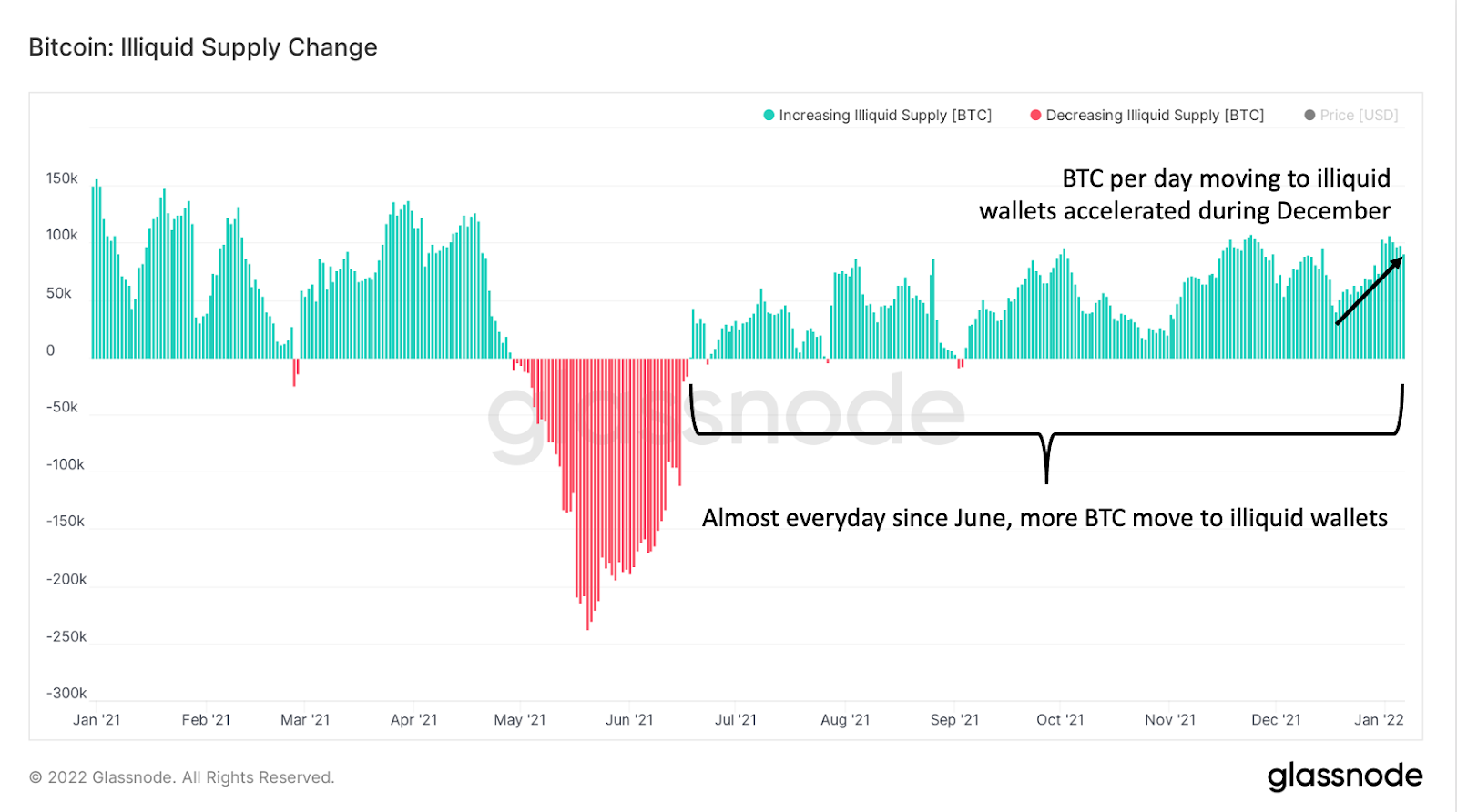
As a result, 76% of all bitcoin ever created are currently not available to be traded. Of the roughly 18.9 million bitcoin that have been mined to date, only 4.5 million are currently liquid.
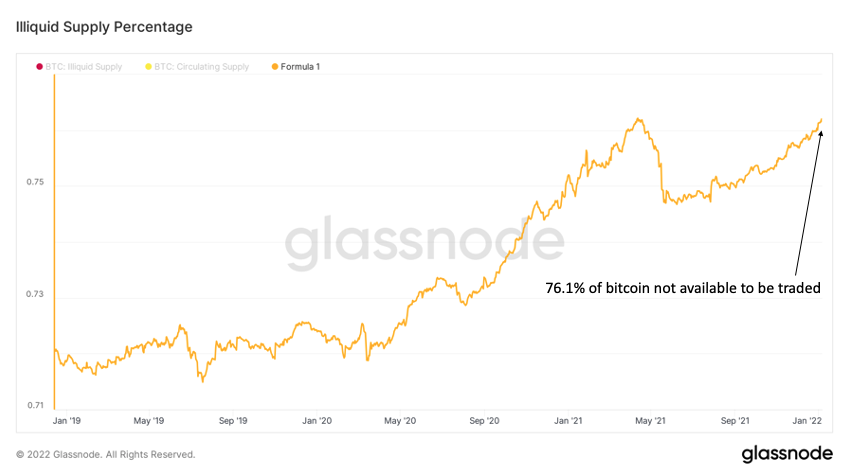
This provides a strong base of holders who are unlikely to sell. In fact, it’s likely due to this base of staunch bitcoin believers that the recent leverage liquidations (more on this below) haven’t caused a larger decrease in price and have kept bitcoin range bounded in the last several weeks. This accumulation by patient investors has also created a supply squeeze. Therefore, over the long term, we believe there is good reason to be optimistic about bitcoin’s future price.
This brings us to the other side of the coin (pun intended). If there is such a large supply squeeze forming, why haven’t we seen a run up in price over the last month? For that, we believe we need to look at the perpetual futures market as well as the cost basis for retail investors.
Let’s start with the Perpetual Futures Market. A perpetual futures contract (aka Perp) is an agreement to buy or sell the underlying asset in the future at a predetermined price. A Perp is very similar to a normal futures contract except that it does not have an expiration date, thus it automatically renews and runs forever until canceled or traded in. Similar to regular futures contracts, it is common to use leverage. Hence, the perpetual open interest can give us an indication about the amount of leverage in the market.
The goal of a perpetual contract is to closely track the price of the underlying asset (in this case BTC). To do so, there is a funding rate. The funding rate is a fee paid by one side of the contract to the other. The purpose of the funding rate is to encourage the price of the Perp to stay near the underlying spot price. If the Perp is trading at a premium to the underlying asset, the funding rate will be positive. This means that longs pay shorts the fee. This incentivizes more traders to become short sellers and pull the price of the perp future back down to the spot price. The fee keeps traders from being too much on one side of the trade.
Simply put, when the funding rate becomes extremely positive it means that there are typically a lot of overleveraged longs, meaning that any downward price movement may trigger a liquidation cascade. That is the scenario that unfolded when the price of BTC fell on December 27th and on January 5th.
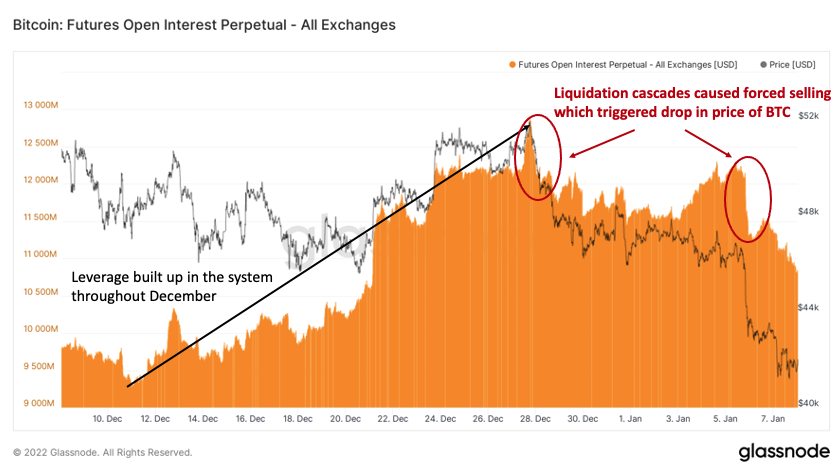
Notice that while the open interest has come down over the last couple of weeks, it’s still elevated. This doesn’t necessarily mean we will have another liquidation event, but the possibility still exists.
The second reason we likely haven’t seen a run up in price despite the supply squeeze is that retail investors haven’t come back into the market since we hit all-time highs in early November. Normally, in periods of rapid price appreciation, we see a large spike in new market participants as rising prices attract new investors who do not want to miss out. We saw this in January/February as well as in September/October of this year. However, since the December 3rd liquidation crash that we covered in the December 12th edition of Node Ahead Newsletter, there hasn’t been much, if any, growth in new entities entering the market.
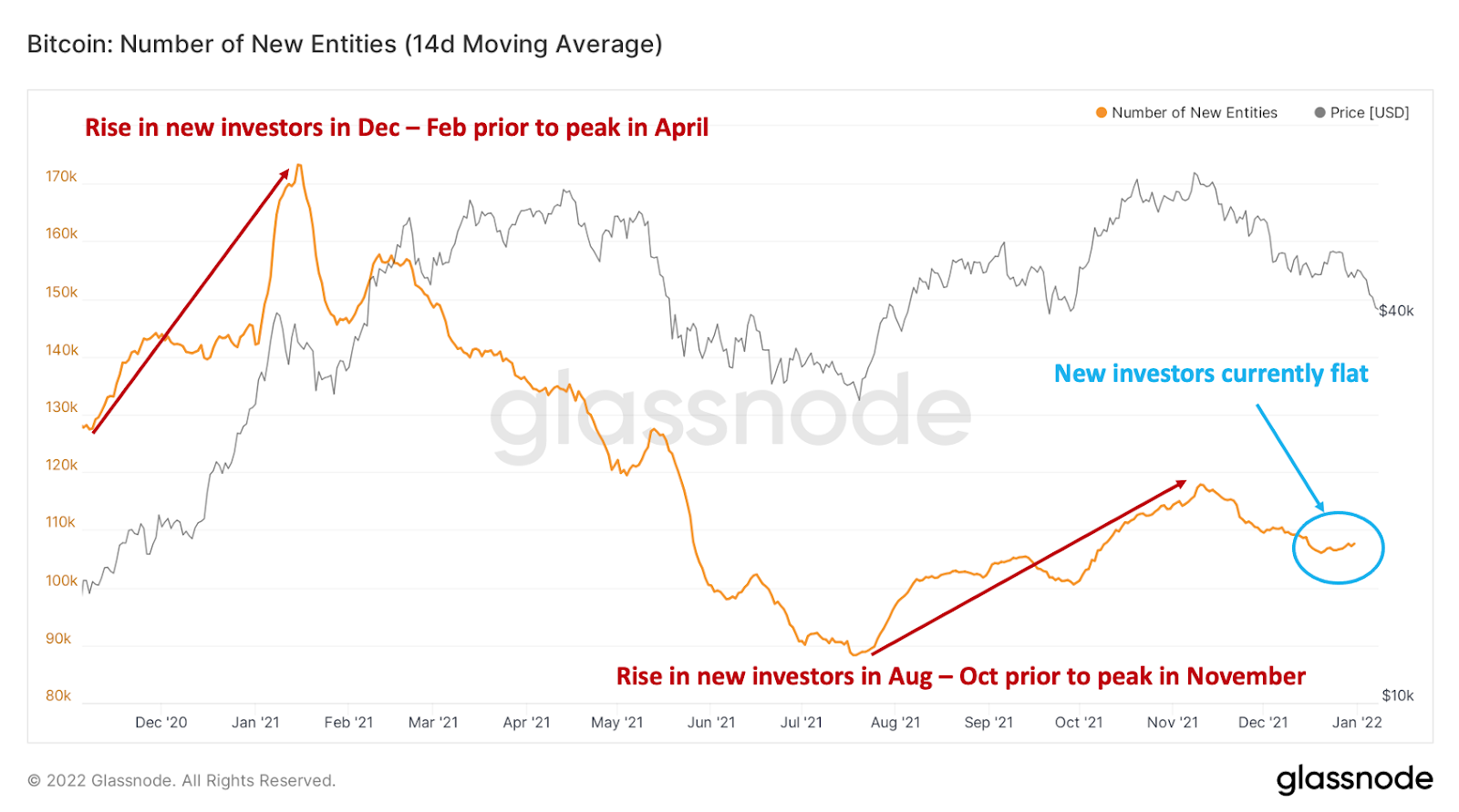
This means that most of those short-term market participants who came into the market in recent months are still underwater. We can verify this by looking at the average price short-term holders paid (aka cost basis) which is currently higher than the price of bitcoin.
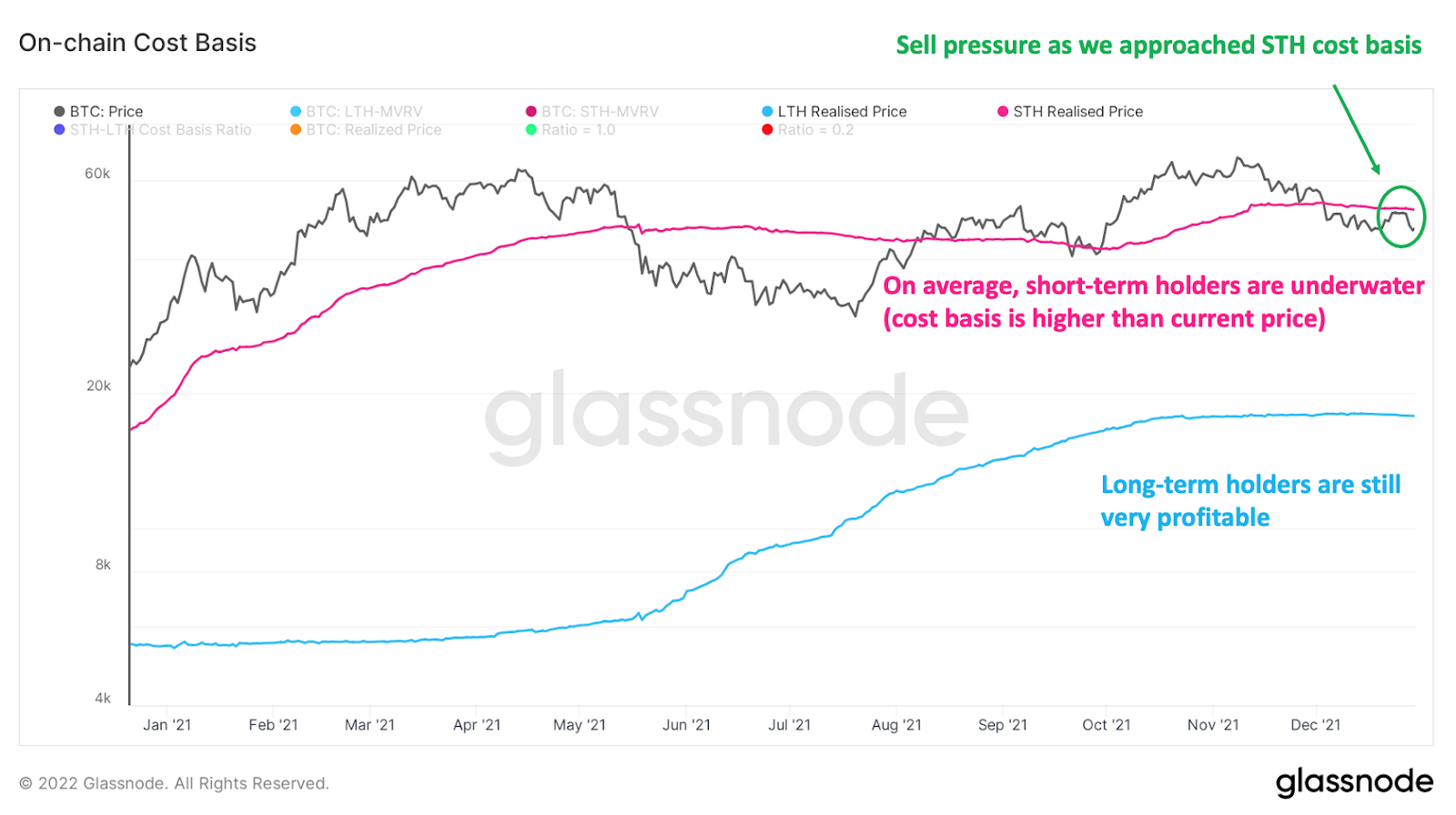
Also notice that, as we approached the short-term holder cost basis towards the end of December, we saw a sell-off. This is likely due to this group of investors just happy to get their initial capital back and decided to sell. This is why this threshold is so key. There is a lot of resistance right now at this $52k mark (short term holder’s cost basis) and until we break above it and hold, we may continue to see volatility in the short term. However, if we break above and stay above it, sell pressure goes away and it becomes more likely for new participants to start entering the market again. This could trigger the price increase we have all been expecting.
Ok, that was a lot. Let’s recap and make this very simple. Institutions and long-term holders continue to accumulate and increase the supply squeeze. At the same time, we still have a fair amount of leverage built up in the perpetual futures market. Retail and short-term players have largely been sitting out since early December or, at the most, selling to recoup their investments. The cost basis for short-term holders ($52k) is likely the key to the upside and until we break through that level, we are likely in for continued volatility in the short term.
As always, the on-chain data is provided by Glassnode. If you would like to have access to the data yourself, you can sign up here.
What OpenDAO’s Airdrop Means for Opensea
OpenSea is the premier destination for buying and selling NFTs, processing 97% of all NFT transactions. Given the rise in popularity of NFTs in 2021, transaction volume on OpenSea surpassed $14 billion this past year, an increase of 646x compared to 2020.
However, rapid growth usually brings along its share of controversies, and OpenSea is no different. During the peak of the NFT mania in September, it was reported that OpenSea’s Head of Product Nate Chastain had used confidential information to buy NFTs before they were promoted on the homepage and then sold them shortly after netting a substantial profit. The company confirmed the allegations of insider trading, and Nate subsequently resigned.
Then, at the beginning of December, the company hired Lyft’s CFO Brian Roberts to be their new CFO. In an interview with Bloomberg, Roberts mentioned that he was already planning to take OpenSea public, something he had done at Lyft. “When you have a company growing as fast as this one, you’d be foolish not to think about going public.” Those comments unleashed a firestorm of criticism and outrage from the crypto community.
Part of the ethos of crypto, web3, and decentralization is that it is owned and operated by the users, not large corporations. So, when the most popular NFT platform decides to do an IPO instead of rewarding its community through a token issuance, that is likely going to be viewed as selling out to large institutional investors, thus creating a ton of backlash. Many consider it to be even more egregious given the fact that a similarly popular community-driven project, ENS Domains, rewarded early users with an airdropped token no less than a month earlier. The next day Roberts tried to walk his statement back, but the damage was evidently done.
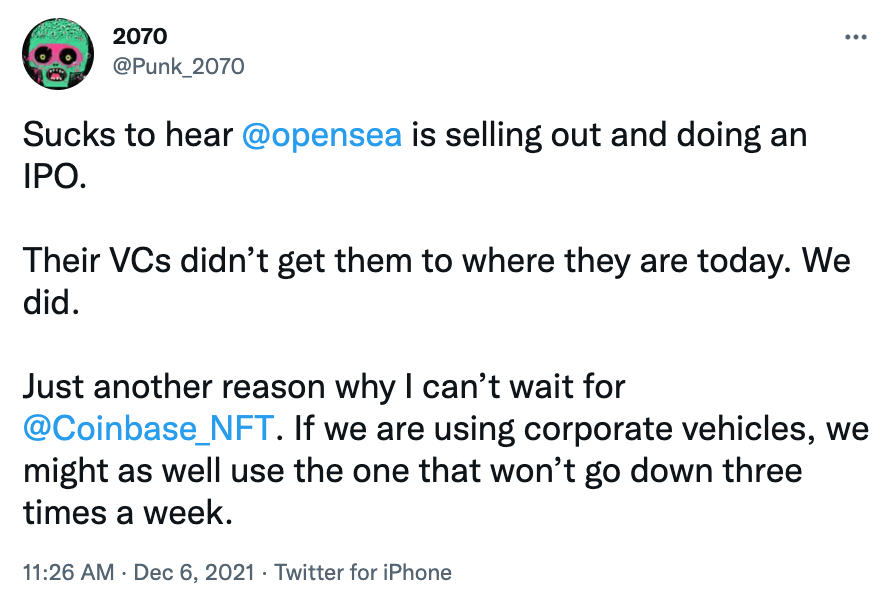
So, what does a passionate, decentralized, tech-savvy community do when they feel betrayed? They take matters into their own hands. Shortly after Roberts’ comments, an anonymous community member going by the Twitter handle 9x9x9eth, launched the OpenDAO to reward early users of the OpenSea platform with an airdropped token. This newly formed Decentralized Autonomous Organization (aka DAO) has no official affiliation with OpenSea. However, because all NFT purchases are publicly viewable on the blockchain, the developers of OpenDAO are able to compile every transaction that has occurred on the OpenSea platform. Thus, OpenDAO is trying to do what OpenSea has refused to do up to this point, reward customers in proportion to how much they used the product, not those who had insider access or lots of money.
In order to do this, OpenDAO conducted what is known as an airdrop. An airdrop involves sending free coins or tokens to wallet addresses in order to reward earlier participants and/or to promote the awareness of a new asset. Those receiving the coins or tokens are not required to purchase them or invest any capital. In the case of the OpenDAO anyone who had transacted on OpenSea before December 23 is eligible to claim free SOS tokens via the airdrop simply by connecting the wallet, they used to buy and hold their NFTs. While the SOS airdrop is for OpenSea users, the marketplace itself doesn’t have anything to do with the distribution. Once OpenDAO announced its plans, the airdrop quickly gathered a lot of attention. Launched on Christmas day, the new token grew to a market cap of over $400m by January 1st.
It will be very interesting to watch what happens to SOS in the coming months and if OpenSea responds by issuing an official token of its own. Either way, the performance of the token is not what is most interesting about this recent event. The key takeaway is that in an open network, the technology, or the platform isn’t what is most valuable or defensible. Open-source code can be copied or forked into similar projects. Data is publicly available, rather than being siloed or controlled by one entity. The most valuable component that any web3 project has is the community that supports and engages with it. Power is beginning to shift away from centralized corporations and slowly swing in favor of the users.
As Reddit founder Alexis Ohanian recently put it “Anyone can show up to a massively successful project and draft on their community and if you offer something more interesting or rewarding, [they can] leapfrog their way into a very motivated Minimum Viable Community overnight.”
Why this matters to RIAs: It’s becoming increasingly likely that clients will receive, if they haven’t already, airdrops of various tokens and coins in the future. It will be important to know what these are and how to advise clients with regards to airdrops.
Major Crypto Bill in the Works
In the last newsletter, we covered the surprisingly positive Washington hearing on cryptoassets and discussed crypto’s growing political influence. Since then, Republican Senator Cynthia Lummis, one of the crypto industry’s staunchest supporters in Congress, announced that she is planning to introduce a comprehensive bill in 2022 that would provide guidelines for categorizing digital assets and create a new regulatory agency to oversee the cryptoasset market.
Lummis sits on the Senate Banking Committee, which oversees banks and coinage, and has been very vocal about the fact that she wants nothing short of full normalization of digital assets in the U.S. Lummis was the first Senator to publicly disclose that she holds bitcoin in her personal portfolio and her state of Wyoming has passed numerous crypto-friendly laws. Her support for the crypto industry led her recently to write an op-ed for the New York Times asking Congress to block the nominations of Jerome Powell and Lael Brainard to the Federal Reserve over their “political approach to digital assets.” So, when Senator Lummis announced she is planning on drafting a bipartisan bill, the entire crypto industry started buzzing.
The senator’s bill, if enacted, would aim to “provide regulators with clear guidance on which assets belong to different asset classes, offer protections for consumers, regulate stablecoins, and create a new organization under the joint jurisdiction of the Commodity Futures Trading Commission and the Securities and Exchange Commission to oversee the digital asset market.”
This would be the first attempt at introducing a comprehensive bill on behalf of the crypto industry. Everything else that has been proposed or enacted up to this point has been centered around a single issue and designed to fit digital assets within the existing regulatory framework. Should this new bill pass, it would likely be an enormously positive step for both the crypto industry and Washington’s growing acceptance of the asset class.
Why this matters to RIAs: Staying up to date on the latest regulatory developments is important to evaluate the risks associated with the crypto industry.
Talent is Flocking to Crypto and Web3
Last week, Electric Capital released its annual developer report which highlights the growth of software engineers working in the crypto industry as well as within various projects. Studying the developer ecosystem behind a number of these projects can provide insights into emerging tokens and coins. Developer growth is often a necessary, though not sufficient, variable in the success of a crypto network and thus can be a leading indicator for which projects are gaining momentum. Electric Capital’s report is always a great read and very thorough so if you would like to check it out for yourself, you can find the report by clicking on this link.
However, if you do not want to read the entire 130-page report, here is the synopsis – talent is migrating to the crypto industry in record numbers. At the end of the year, monthly active developers were at an all-time high and accelerating.
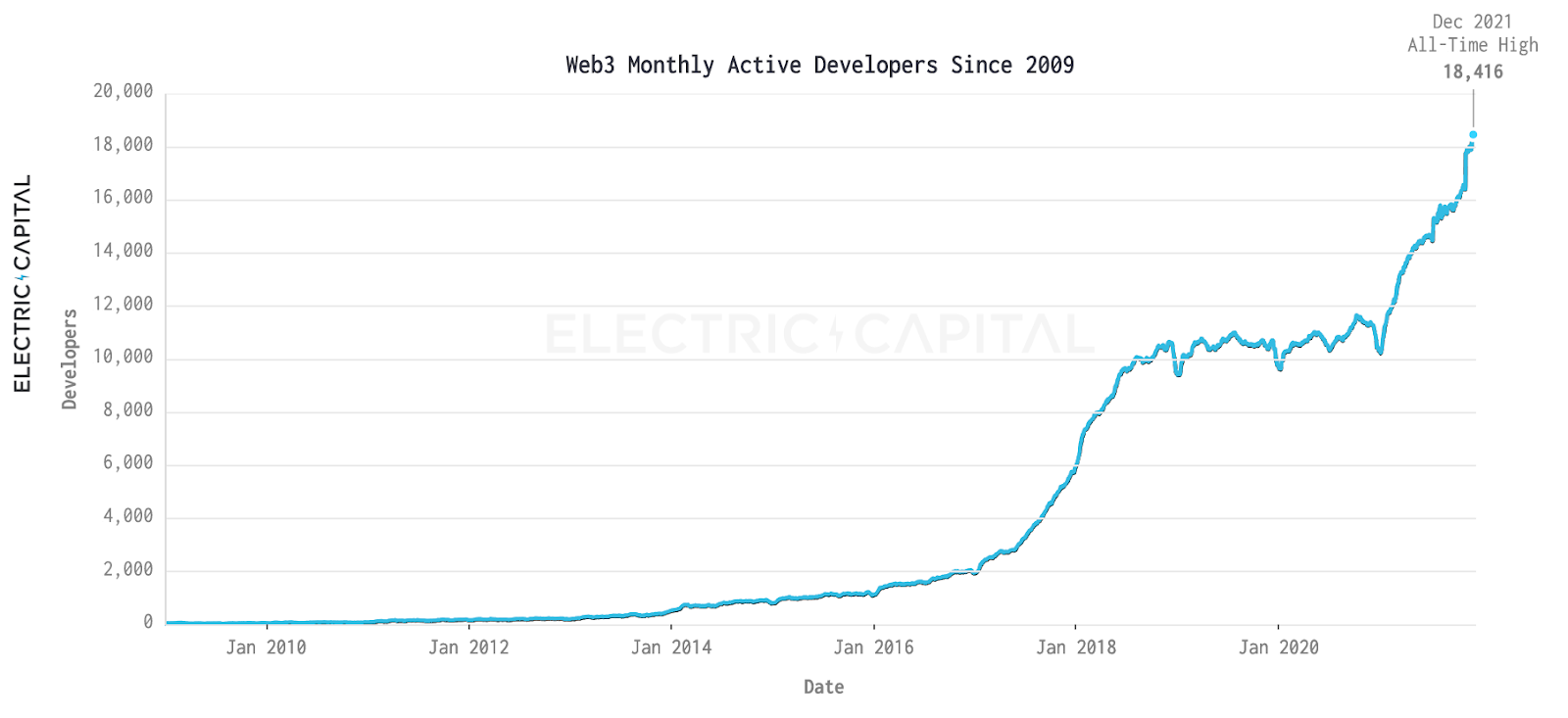
In fact, more developers joined crypto and web3 related projects in 2021 than any other year in the industry’s 13-year history.
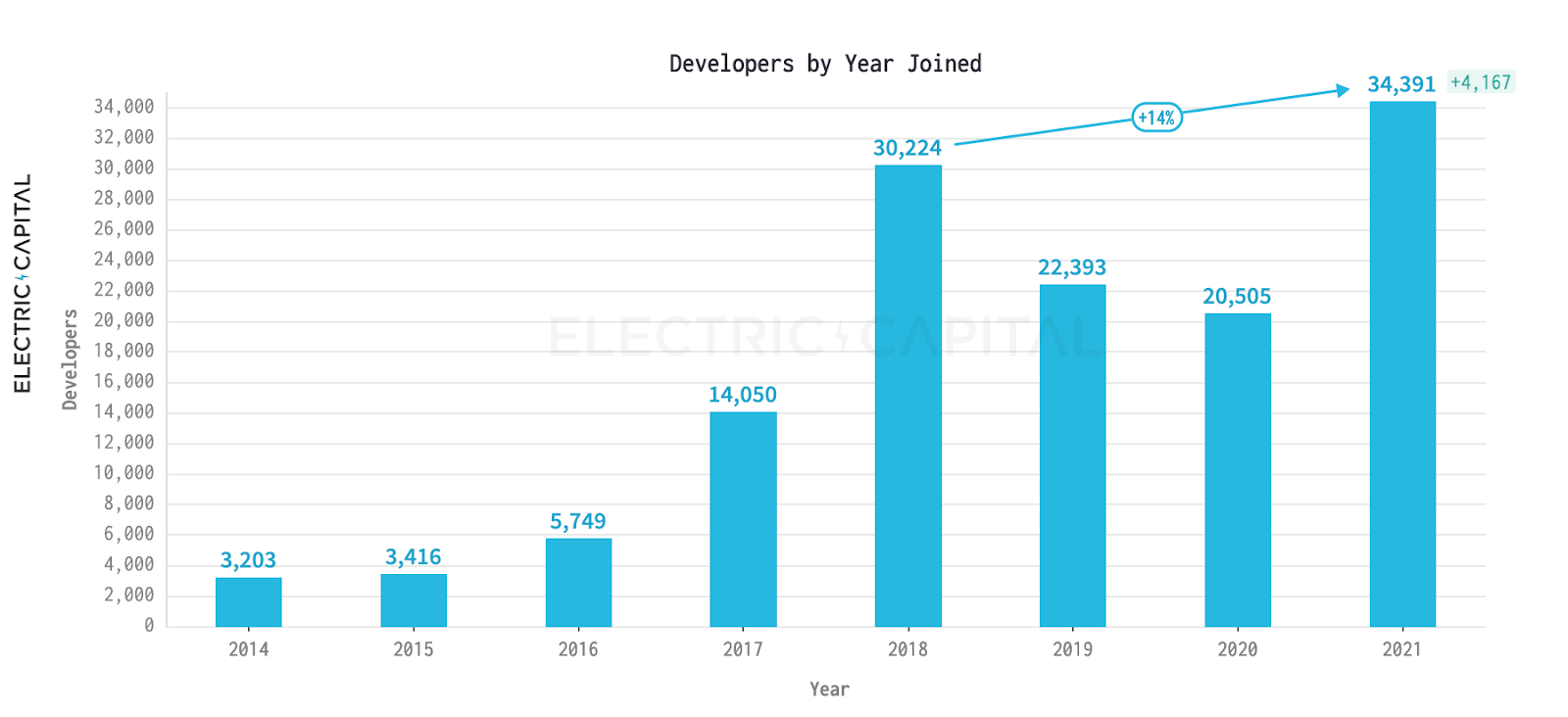
While Ethereum (4,000+) and Bitcoin (680+) have the most monthly active developers, there are several other vibrant ecosystems. Polkadot, Cosmos, and Solana are the next largest ecosystems with Solana growing the fastest of this category (almost 5x’d the total number of developers in 2021). Interestingly, Solana, Binance, Avalanche, Terra, Polkadot, and NEAR are all growing faster than Ethereum did at the same point in their respective histories.
An increasing number of top engineering talent is leaving traditional industries, including big tech, to work in crypto. What is even more encouraging is that although developers continue to flock to this industry in record numbers, crypto developers still represent a small percent of software engineers globally. Just another reminder that we are still very early and have a ton of growth ahead of us.
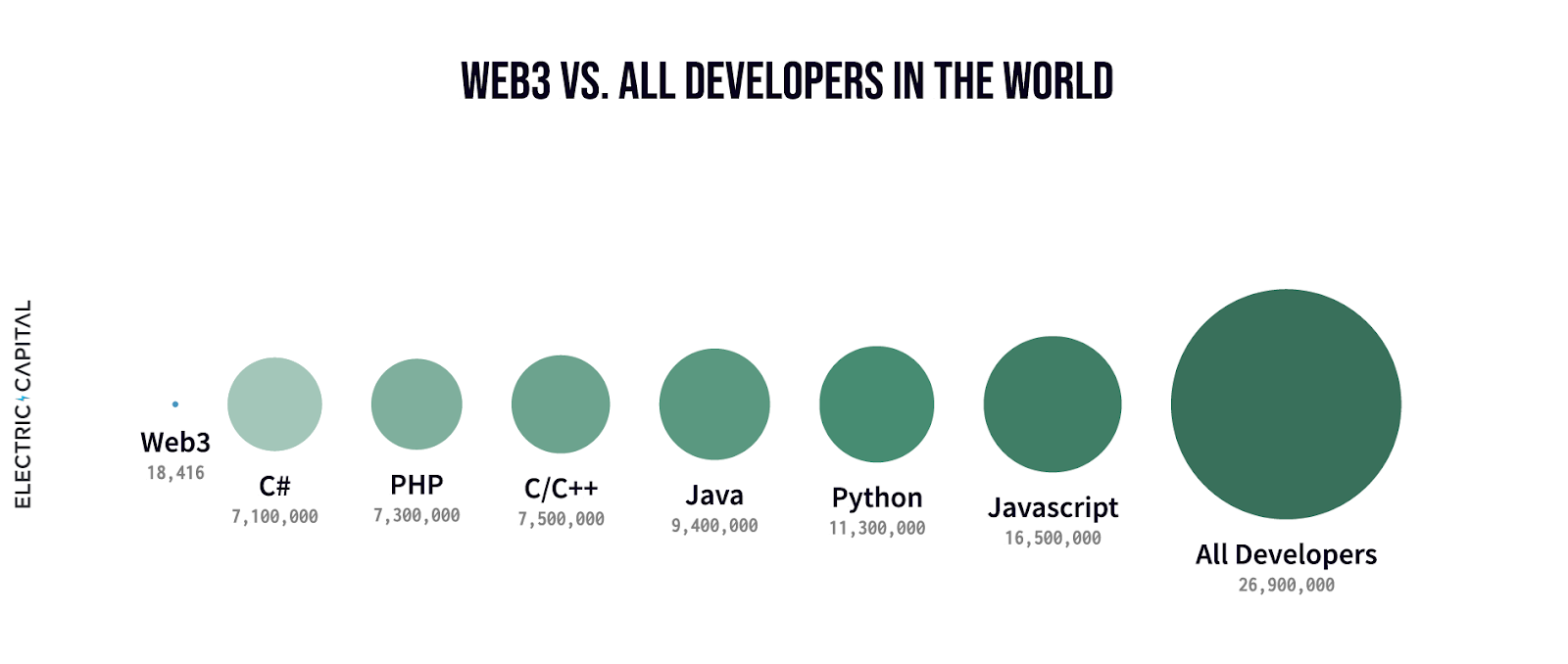
Why this matters to RIAs: There are more ways to measure the growth of an industry than simply price and market cap. Understanding that engineering talent continues to flow to the crypto industry and which projects are attracting the most talent can help advisors make better decisions on behalf of their clients.
In Onramp News
- On Purpose: Tyrone Ross’ State of the Union: Onramp’s Story
- On Purpose: State of the Union Part 2: Education, Access, and Tools
- Forecast for Crypto in 2022 as Slump Continues into New Year
- Caitlin Cook: What to Know About Bitcoin Futures ETFs in 2022
- Giving Back, Giving Big – InsuranceNewsNet
- The Top Investing Story of 2021: Investing in Cryptocurrency and Digital Assets
- Riskalyze Fintech Report Card: December 2021
- Prime Trust Sees Strong Growth In 2021 Outpacing Last Year’s Success – Biznewspost
- Talking Crypto, Community, and Career Moves with Torie Happe, Head of Business Development for Onramp Invest
- Orion’s The Weighing Machine: Inflation and the Economy Today with Jeremy Schwartz on Apple Podcasts
- Girls Just Wanna Have Funds podcast – How to Understand the Crypto Craze featuring Caitlin Cook (S2EP13)
In Other News
$87 billion Italian bank with more than 300,000 customers to allow customers to buy bitcoin starting early this year.
Goldman Sachs expects bitcoin to steal more market share from gold and could possibly get to $100,000.
Jake Chervinsky, head of policy at the Blockchain Association, writes about why the U.S. should support the nascent stablecoin industry rather than pursue a central bank digital currency. U.S. Rep. Tom Emmer of Minnesota makes a similar case.
Airbnb co-founder and CEO Brian Chesky said that support for cryptocurrency payments tops the list for most-requested products in 2022.
Terra blockchain’s (a Blockforce portfolio asset) fast growing stablecoin UST, which had surpassed its rival DAI to become the world’s largest decentralized stablecoin by market value, has now attained another milestone: a market capitalization of $10 billion.
Big name hedge funds such as Coatue Management and Tiger Global Management are increasingly investing in crypto.
Square Enix president Yosuke Matsuda spent much of a January 1st letter discussing what he termed “decentralized gaming,” noting that “I hope this becomes a major trend in gaming going forward.”
After a steady decline in volume transacted over the last couple months in 2021, the NFT market is booming again at the start of 2022.
The HRF recently announced they will be giving 4.25 bitcoin to 10 different developers, each working on a different aspect of the Bitcoin network, including Lightning, Bitcoin Core, education, translation, and wallet development.
Political unrest in Kazakhstan led authorities to restrict internet access, affecting miners in the country and leading to a drop in the Bitcoin network hash rate.
Popular trading platform Robinhood announced that the beta version of their crypto wallet will launch in mid-January.
With gratitude,
Your Onramp Family
